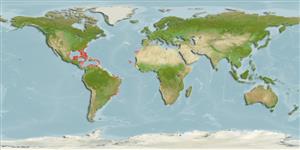Actinopterygii (ray-finned fishes) >
Anguilliformes (Eels and morays) >
Congridae (Conger and garden eels) > Heterocongrinae
Etymology: Heteroconger: Greek, heteros = other + Latin, conger = conger (Ref. 45335). More on author: Günther.
Environment / Climate / Range
Ecology
Marine; reef-associated; non-migratory; depth range 10 - 60 m (Ref. 26938), usually 20 - 60 m (Ref. 7251). Tropical, preferred ?
Eastern Atlantic: known only from Madeira, Canary Islands and Senegal. Western Atlantic: Bahamas, Florida keys, Antilles, Yucatan, Belize and Honduras (Ref. 26938); extending to Brazil (Ref. 40101).
Size / Weight / Age
Maturity: Lm ? range ? - ? cm
Max length : 51.0 cm TL male/unsexed; (Ref. 7251)
Short description
Morphology | Morphometrics
Eye large. Lower jaw longer than upper; 157 to 165 vertebrae (Ref. 26938).
Found on sandy bottom, living in colonies (Ref. 26938). Feed on plankton and detritus (Ref. 26938). They retreat into burrow when frightened (Ref. 9710). Probably spawn during warm season (Ref. 6521). Larval life spans 6-8 months (Ref. 6521).
Life cycle and mating behavior
Maturity | Reproduction | Spawning | Eggs | Fecundity | Larvae
Smith, D.G., 1990. Congridae. p. 156-167. In J.C. Quero, J.C. Hureau, C. Karrer, A. Post and L. Saldanha (eds.) Check-list of the fishes of the eastern tropical Atlantic (CLOFETA). JNICT, Lisbon; SEI, Paris; and UNESCO, Paris. Vol. 1. (Ref. 4453)
IUCN Red List Status (Ref. 115185)
CITES (Ref. 94142)
Not Evaluated
Threat to humans
Harmless
Human uses
More information
Common namesSynonymsMetabolismPredatorsEcotoxicologyReproductionMaturitySpawningFecundityEggsEgg development
ReferencesAquacultureAquaculture profileStrainsGeneticsAllele frequenciesHeritabilityDiseasesProcessingMass conversion
Tools
Special reports
Download XML
Internet sources
